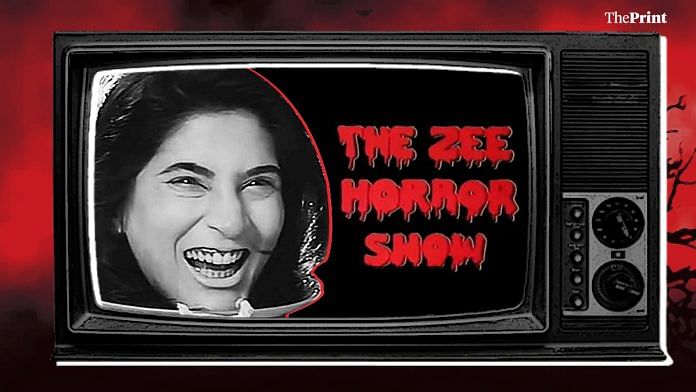
New Delhi: For the ’90s generation, the image of actress Archana Puran Singh’s face stretched in a devilish grin superimposed on a saucer immediately recalls The Zee Horror Show, also known as Anhonee.
An anthology of paranormal stories, the show that ran on Zee channel from 1993 to 2001 was one of India’s first weekly horror series.
That iconic scene of the face on the saucer was from the show’s first episode, titled ‘Dastak‘. Full of jump scares — a technique used in films to scare the audience with abrupt images, events or sounds — and a suspenseful background music score, the episode follows the story of a woman called Julie.
Julie, played by Archana Puran Singh, is murdered by her husband but returns as a ghost to avenge her death.
While there were other horror serials such as Doordarshan’s Quile ka Rahasya (1989) at the time, The Zee Horror Show quickly gained a name for itself as well as a cult following.
Last year, amid the nationwide lockdown, Zee TV announced a re-telecast of the hit horror show, sending fans into a frenzy.
Dehshat fir degi aapke darwaze pe dastak, kyunki aane wala hai #TheZeeHorrorShow kal se raat 11:30 baje, sirf #ZeeTV par. #DehshatPhirDegiDastak pic.twitter.com/oZneGtkRC4
— ZeeTV (@ZeeTV) April 26, 2020
On social media, fans have since asked for all the episodes to be re-telecast, not just a select few while others looked forward to reliving childhood memories.
Also read: RimZim, popular desi jeera drink bought and relaunched by Coca-Cola before it lost all fizz
Created by a band of brothers
The Zee Horror Show was created by the seven Ramsay brothers — Tulsi, Shyam, Gangu, Kumar, Keshu, Kiran, and Arjun. The family dominated the spooky genre of Indian cinema in the 1970s and 1980s with hit films such as Purana Mandir (1984) and Veerana (1988).
Their projects didn’t just feature reanimated corpses like Julie but also all kinds of ghosts and ghouls — even snowmen — backed by haunting theme music and chilling stories.
According to author Amborish Roychoudhury’s book, ‘In A Cult of Their Own: Bollywood Beyond Box Office‘, the origins of the horror empire can be traced to the decision of the family patriarch, Fatehchand U Ramsinghani.
Ramsinghani used to own a radio shop in Karachi in undivided India. After Partition, he relocated to Mumbai, entered the film production business, and shortened his last name to ‘Ramsay’. He tasted success with conventionally made films such as Rustom Sohrab (1963), starring Prithviraj Kapoor and Suraiya. Later, he pulled his seven sons into the business as well.
Despite initial success, horror films in India struggled to find footing in an industry that was heading in a different direction. Speaking to ThePrint, former film critic Rajeev Masand explained: “After the ’80s and ’90s, horror as a genre fizzled out in India. Led by Yash Raj Films and Dharma Productions, there was a turn towards family films and even action took a backseat for a while.”
The Ramsay brothers also had to suffer financial loss — Ek Nanhi Munni Si Ladki (1970), starring Prithviraj Kapoor and Shatrughan Sinha, turned out to be a flop.
A family production full of ‘jugaad’ techniques
With seven brothers on set, every project by the Ramsay brothers was a family production. Each brother had a role to play — Tulsi and Shyam were usually the directors. Kumar wrote the script. Kiran was in charge of sound. Ganguly was the cameraman. Keshu assisted in cinematography while doubling up as the producer. Arjun, meanwhile, handled post-production and editing.
“Their mother and wives cooked food for the cast and crew, while also handling make-up,” Roychoudhury wrote in his book.
The Zee Horror show was created with a similar set-up.
According to film director Vivek Agnihotri, who knew the brothers, having more hands on deck was cost-effective. “Horror requires a lot of special effects, different lighting, prosthetics, and extravagant sets but at that time, the budgets were really small. The Zee Horror Show would not have got more than Rs 1 lakh per episode, and producers would not have worked for more than 10-15 per cent of their profits,” he told ThePrint.
The Ramsay brothers also used ‘jugaad’ techniques or hacks to achieve special effects, recalled Agnihotri. “Let’s say there was a scene with a squeaking door. Today, you can motorise an effect like that but they would tie some part of the door with thread and have someone pull it from behind,” he explained.
In the late ‘90s, Agnihotri was approached by Subhash Chandra, founder of Zee TV, and Vishnu Patel, Zee’s creative head at the time, to do an upgraded version of The Zee Horror Show. This led to X-Zone, the Ramsays’ take on the famous American science fiction show, the X-Files.
According to reports, the show was enjoyed by many and had TRP ratings as “high” as The Zee Horror Show.
X-Zone aired on Zee in June 1998 and ran parallel to The Zee Horror Show. Tulsi and Shyam directed a few of its episodes.
(Edited by Paramita Ghosh)
Also read: Filmistan, studio that released many top grossing-films in 1940s-50s & then fell off the map

COMMENTS